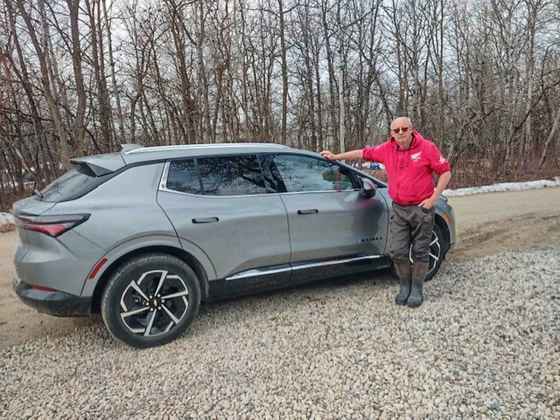|
The tale of John Kolisnyk and his exorbitant bill for charging his 2025 Chevrolet Equinox seems to be the proverbial canary in the coal mine for a number of government-driven initiatives.
The Dauphin resident was charged $681.36 for 113 minutes of charging his EV at a dealership while in Swan River for a medical appointment. It might be easy to paint the dealer as the bad guy, but there’s more nuance to the story than first appears.
A transition to electric vehicles is, currently, largely driven by governments at multiple levels. The federal government has a mandate to have 100 per cent of new vehicles sold be zero-emission by 2035. At the same time, it’s ended federal subsidies for buyers and has, arguably, been deficient in providing or encouraging the installation of charging facilities, according to the Canadian Automobile Dealers Association.

Dauphin resident John Kolisnyk with his 2025 Chevrolet Equinox (Supplied)
Meanwhile, conscious of that federal mandate, automobile manufacturers are pressuring dealerships to sign up their technicians for EV training, install EV infrastructure such as repair facilities and charging stations and, in some cases, not giving individual dealerships much discretion in matching the investments to the projected EV sales. It can be a significant investment — the Swan River dealership said its fast charger alone was $86,000 — with only a negative return on investment, at least right now.
In rural communities such as Swan River, particularly given the current state of charging, vehicle range and available charging infrastructure, projected EV sales hover around, well, zero. Government stepping in to regulate EV charging rates — as Finance Minister Adrien Sala has promised — makes sense in areas with enough daily use that even regulated charging prices can result in a return on investment, but in areas where charging use will be sporadic at best, it will only discourage businesses such as the Swan River dealership from installing charging at all.
Advertisement
 Why this ad? Why this ad?
As with the demand for more affordable housing, the EV situation highlights how, if governments want industry to go in a certain direction, it’s incumbent upon government to help. Bankrupting a dealership, industry or real estate developer is not going to drive change, it’s going to drive change away.
This is something the City of Winnipeg is recognizing. Its latest strategy for affordable housing is to negotiate with developers for use of existing, unused city-owned land. By helping with the cost of development, and allowing a blend of market rents and affordable rents, both the city’s goals and developer’s goals are attainable.
The two situations form a study in contrast: instead of issuing demands and expecting industry to comply, the City of Winnipeg is working on solutions. The automotive industry is hoping the federal government will do the same.
|

